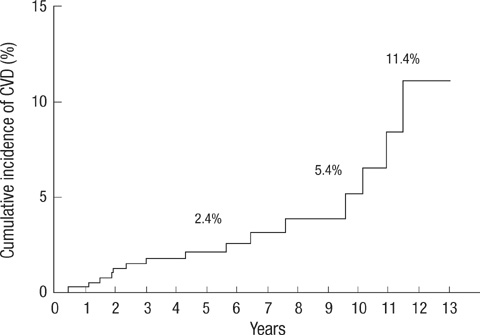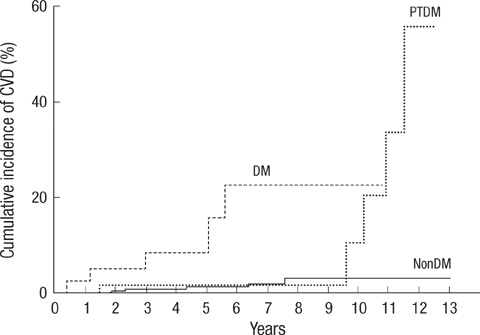J Korean Med Sci.
2010 Nov;25(11):1589-1594. 10.3346/jkms.2010.25.11.1589.
Cardiovascular Diseases after Kidney Transplantation in Korea
- Affiliations
-
- 1Department of Internal Medicine, Seoul National University Hospital, Seoul, Korea.
- 2Transplantation Research Institute, Seoul National University, Seoul, Korea.
- 3Department of Internal Medicine, Eulji General Hospital, Eulji University College of Medicine, Seoul, Korea.
- 4Transplantation Center, Seoul National University Hospital, Seoul, Korea.
- 5Department of Surgery, Seoul National University College of Medicine, Seoul, Korea.
- KMID: 1779228
- DOI: http://doi.org/10.3346/jkms.2010.25.11.1589
Abstract
- Cardiovascular disease (CVD) is the leading cause of death in renal allograft recipients with functioning graft. Our study aimed to determine the incidence and the risk factors of cardiovascular disease after renal transplantation in Korea. We retrospectively analyzed 430 adult recipients who underwent kidney transplantation between January 1997 and February 2007. CVD was defined as a composite outcome of ischemic heart disease, cerebrovascular accident and peripheral vascular disease. Mean age of recipients was 40.0+/-11.8 yr. Mean duration of follow-up was 72+/-39 months. The cumulative incidence of CVD after renal transplantation was 2.4% at 5 yr, 5.4% at 10 yr and 11.4% at 12 yr. Multivariate analysis revealed that recipient's age, diabetes mellitus and duration of dialysis before transplantation were associated with post-transplant CVD (hazard ratio 1.843 [95% CI, 1.005-3.381], 3.846 [95% CI, 1.025-14.432] and 3.394 [95% CI, 1.728-6.665] respectively). In conclusion, old age, duration of dialysis and diabetes mellitus are important risk factors for post-transplant CVD, although the incidence of post-renal transplant CVD is lower in Korea than that in western countries.
Keyword
MeSH Terms
Figure
Cited by 1 articles
-
Current Management for Patients on the Waiting List of Deceased Donor Kidney Transplantation in Korea
Kitae Bang, Myung-gyu Kim, Nyeonim Byeon, Yoonjung Kim, Cheol Jeong Jong, Han Ro, Kyu Oh Yun, Sang-il Min, Jongwon Ha, WonHyun Cho, Jaeseok Yang, Curie Ahn
J Korean Soc Transplant. 2010;24(4):272-283. doi: 10.4285/jkstn.2010.24.4.272.
Reference
-
1. Kim SM, Lee C, Lee JP, Kim EM, Ha J, Kim SJ, Park MH, Ahn C, Kim YS. Kidney transplantation in sensitized recipients; a single center experience. J Korean Med Sci. 2009. 24:Suppl 1. S143–S147.
Article2. Yoon HE, Hyoung BJ, Hwang HS, Lee SY, Jeon YJ, Song JC, Oh EJ, Park SC, Choi BS, Moon IS, Kim YS, Yang CW. Successful renal transplantation with desensitization in highly sensitized patients: a single center experience. J Korean Med Sci. 2009. 24:Suppl 1. S148–S155.
Article3. USRDS 2008 Annual report. USRDS. accssed on 28 September 2009. Available at http://www.usrds.org/2008/pdf/V2_07_2008.pdf.4. Lentine KL, Brennan DC, Schnitzler MA. Incidence and predictors of myocardial infarction after kidney transplantation. J Am Soc Nephrol. 2005. 16:496–506.
Article5. Vanrenterghem YF, Claes K, Montagnino G, Fieuws S, Maes B, Villa M, Ponticelli C. Risk factors for cardiovascular events after successful renal transplantation. Transplantation. 2008. 85:209–216.
Article6. Harland JO, Unwin N, Bhopal RS, White M, Watson B, Laker M, Alberti KG. Low levels of cardiovascular risk factors and coronary heart disease in a UK Chinese population. J Epidemiol Community Health. 1997. 51:636–642.
Article7. Levey AS, Beto JA, Coronado BE, Eknoyan G, Foley RN, Kasiske BL, Klag MJ, Mailloux LU, Manske CL, Meyer KB, Parfrey PS, Pfeffer MA, Wenger NK, Wilson PW, Wright JT Jr. Controlling the epidemic of cardiovascular disease in chronic renal disease: what do we know? What do we need to learn? Where do we go from here? National Kidney Foundation Task Force on Cardiovascular Disease. Am J Kidney Dis. 1998. 32:853–906.
Article8. Kasiske BL, Maclean JR, Snyder JJ. Acute myocardial infarction and kidney transplantation. J Am Soc Nephrol. 2006. 17:900–907.
Article9. Artz MA, Boots JM, Ligtenberg G, Roodnat JI, Christiaans MH, Vos PF, Blom HJ, Sweep FC, Demacker PN, Hilbrands LB. Improved cardiovascular risk profile and renal function in renal transplant patients after randomized conversion from cyclosporine to tacrolimus. J Am Soc Nephrol. 2003. 14:1880–1888.
Article10. Kim HW, Kang SW, Lee HY, Choi DH, Shim WH, Kim SI, Kim YS, Choi KH. Correlates of the severity of coronary atherosclerosis in long-term kidney transplant patients. J Korean Med Sci. 2010. 25:706–711.
Article11. Liu J, Hong Y, D'Agostino RB Sr, Wu Z, Wang W, Sun J, Wilson PW, Kannel WB, Zhao D. Predictive value for the Chinese population of the Framingham CHD risk assessment tool compared with the Chinese Multi-Provincial Cohort Study. JAMA. 2004. 291:2591–2599.
Article12. Wilson PW, D'Agostino RB, Levy D, Belanger AM, Silbershatz H, Kannel WB. Prediction of coronary heart disease using risk factor categories. Circulation. 1998. 97:1837–1847.
Article13. Kasiske BL, Chakkera HA, Roel J. Explained and unexplained ischemic heart disease risk after renal transplantation. J Am Soc Nephrol. 2000. 11:1735–1743.
Article14. Cosio FG, Kudva Y, van der Velde M, Larson TS, Textor SC, Griffin MD, Stegall MD. New onset hyperglycemia and diabetes are associated with increased cardiovascular risk after kidney transplantation. Kidney Int. 2005. 67:2415–2421.
Article15. Kasiske BL, Snyder JJ, Gilbertson D, Matas AJ. Diabetes mellitus after kidney transplantation in the United States. Am J Transplant. 2003. 3:178–185.
Article16. Shah T, Kasravi A, Huang E, Hayashi R, Young B, Cho YW, Bunnapradist S. Risk factors for development of new-onset diabetes mellitus after kidney transplantation. Transplantation. 2006. 82:1673–1676.
Article17. Meier-Kriesche HU, Port FK, Ojo AO, Rudich SM, Hanson JA, Cibrik DM, Leichtman AB, Kaplan B. Effect of waiting time on renal transplant outcome. Kidney Int. 2000. 58:1311–1317.
Article18. Mallamaci F, Tripepi G, Cutrupi S, Malatino LS, Zoccali C. Prognostic value of combined use of biomarkers of inflammation, endothelial dysfunction, and myocardiopathy in patients with ESRD. Kidney Int. 2005. 67:2330–2337.
Article19. Hernandez D, Rufino M, Bartolomei S, Gonzalez-Rinne A, Lorenzo V, Cobo M, Torres A. Clinical impact of preexisting vascular calcifications on mortality after renal transplantation. Kidney Int. 2005. 67:2015–2020.20. Ligtenberg G, Hene RJ, Blankestijn PJ, Koomans HA. Cardiovascular risk factors in renal transplant patients: cyclosporin A versus tacrolimus. J Am Soc Nephrol. 2001. 12:368–373.21. Morales JM, Dominguez-Gil B. Impact of tacrolimus and mycophenolate mofetil combination on cardiovascular risk profile after kidney transplantation. J Am Soc Nephrol. 2006. 17:S296–S303.
Article22. Shihab FS, Waid TH, Conti DJ, Yang H, Holman MJ, Mulloy LC, Henning AK, Holman J Jr, First MR. Conversion from cyclosporine to tacrolimus in patients at risk for chronic renal allograft failure: 60-month results of the CRAF Study. Transplantation. 2008. 85:1261–1269.
Article



